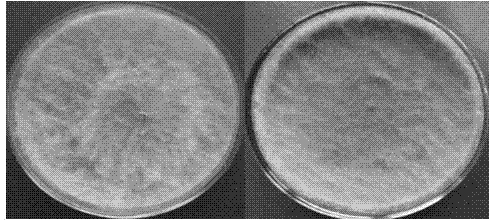Application of Lasiodiplodia pseudotheobromae or its fermentation products in prevention and treatment of wheat powdery mildew
A technology of wheat powdery mildew and fermentation products, applied in the field of microorganisms, can solve the problems of wheat powdery mildew bacteria that have not been reported in the literature, and achieve high antagonistic activity and high biocontrol activity
- Summary
- Abstract
- Description
- Claims
- Application Information
AI Technical Summary
Problems solved by technology
Method used
Image
Examples
Embodiment 1
[0025] Example 1: Isolation of endophytic fungus LPS-1
[0026] Rinse the stems of the collected medicinal plant Lycidium chinensis under running water to remove the silt attached to the surface. The separation of endophytic fungi adopts the conventional tissue separation method. The sample is first washed twice with sterile water, cut into 1-2 cm long pieces, soaked in 75% alcohol for 1-2 minutes, and rinsed with sterile water for 2-3 minutes. Second-rate. Then disinfect with sodium hypochlorite with 1.5% available chlorine content for 7-10 minutes, rinse with sterile water for 3 times, cut the surface-sterilized tissue into 0.2 cm×0.2 cm fragments with a sterilized blade in a sterilized petri dish, Use sterilized filter paper to fully absorb the moisture on the surface of the sterilized tissue block. Finally, the tissue pieces were transplanted onto PDA medium (containing 50 U / mL streptomycin sulfate and ampicillin) plates and placed in a constant temperature incubator a...
Embodiment 2
[0027] Embodiment 2: endophytic fungus LPS-1 fermented liquid is to the activity measurement of wheat powdery mildew
[0028] Shake flask static fermentation method: the fresh endophytic fungus LPS-1 cultivated on the PDA was punched into a cake with a sterilized puncher with a diameter of 6 mm in the ultra-clean workbench, inoculated into a 100 mL Erlenmeyer flask and filled with 30 Milliliter malt essence medium, culture temperature 25 ℃, culture 7 days. The non-inoculated malt essence medium was used as blank control. Malt extract medium formula: malt extract 19.95g / L, sucrose 50 g / L, sodium nitrate 7.5 g / L, magnesium sulfate heptahydrate 3.561 g / L, deionized water 1L.
[0029] After fermentation, the fermentation broth was filtered and centrifuged at 11000 rpm for 10 min. Take the supernatant for later use. Using the isolated leaf segment method, the first leaf of wheat cultured to one leaf and one heart was cut into 30 mm long leaf segments, and placed on 0.5% water ...
Embodiment 3
[0034] Example 3: Observation of Morphological Characteristics of Endophytic Fungus LPS-1
[0035] The endophytic fungus LPS-1 was cultured on PDA medium at 25°C. The colony was round, with neat edges, and was initially white. On the third day, it gradually turned dark gray from the center of the inoculation point, and the mature colony was black. The aerial hyphae are developed, and the colony is fluffy, and gradually thickens into a tapetum. The hyphae are single, black, strong, long, multi-branched, without septa, and do not produce spores on PDA medium.
[0036] To induce sporulation, place sterilized pine needles on the surface of a 2% water agar plate, insert endophytic fungus LPS-1 into the plate, place it in a 25°C incubator, and cultivate under ultraviolet light and ordinary light for 12 hours alternately in light and dark In 2-5 weeks, black sporozoites (i.e. pycnidia) began to form on the pine needles. There are transparent lateral filaments in the pycnidia, cyl...
PUM
 Login to View More
Login to View More Abstract
Description
Claims
Application Information
 Login to View More
Login to View More - R&D
- Intellectual Property
- Life Sciences
- Materials
- Tech Scout
- Unparalleled Data Quality
- Higher Quality Content
- 60% Fewer Hallucinations
Browse by: Latest US Patents, China's latest patents, Technical Efficacy Thesaurus, Application Domain, Technology Topic, Popular Technical Reports.
© 2025 PatSnap. All rights reserved.Legal|Privacy policy|Modern Slavery Act Transparency Statement|Sitemap|About US| Contact US: help@patsnap.com



